
http://www.iaeme.com/IJM/index.asp 22 editor@iaeme.com
International Journal of Management (IJM)
Volume 9, Issue 5, September–October 2018, pp. 22–30, Article ID: IJM_09_05_004
Available online at
http://www.iaeme.com/ijm/issues.asp?JType=IJM&VType=9&IType=5
Journal Impact Factor (2016): 8.1920 (Calculated by GISI) www.jifactor.com
ISSN Print: 0976-6502 and ISSN Online: 0976-6510
© IAEME Publication
EFFECT OF SERVICE THE QUALITY ON
CUSTOMER SATISFACTION AT THE A
BEAUTY CLINIC
Aldiga Rienarti Abidin
Graduate, Master of Public Health Education Program,
Pekanbaru Hang Tuah Institute of Health, Riau Province, Indonesia
Buchari Lapau
Professor of Epidemiology,
Pekanbaru Hang Tuah Institute of Health, Riau Province, Indonesia
Arnawilis
Lecturer of Hospital Administration,
Pekanbaru Hang Tuah Institute of Health, Riau Province, Indonesia
Mitra
Lecturer of Biostatistics,
Pekanbaru Hang Tuah Institute of Health, Riau Province, Indonesia
Jasrida Yunita
Lecturer of Public Health,
Pekanbaru Hang Tuah Institute of Health, Riau Province, Indonesia
ABSTRACT
Background: Customer satisfaction is a level of customer feeling appearing
because of service performance she obtains compared to her expectation.
Unsatisfaction appears in a beauty clinic because she finds the gap between her
expectation and service performance felt by her at the time using the services. Based
on the presurvey, 18 (36%) of 50 customers interviewed felt unsatisfactory on the
service of the A Beauty Clinic. The objective of the study is to find an association
between several quality factors and customer satisfaction.
Material and methods: The design type of study was an analytic cross-sectional
study. The population of this study was customers > 16 years old who ever visited the
A Beauty Clinic in the last year. Based on the analytic cross-sectional study, the result
of sample size calculation by using 5% alpha errors and 10% beta errors was 200.
The sampling procedure was taking each sample consecutively reaching 200 at the
Beauty Clinic. Data analyzed by univariate, bivariate, and multiple logistic regression
analysis.

Aldiga Rienarti Abidin, Buchari Lapau, Arnawilis, Mitra, Jasrida Yunita
http://www.iaeme.com/IJM/index.asp 23 editor@iaeme.com
Result: Tangible service quality associated with customer satisfaction. Brand
image confounding to tangible service quality.
Conclusion: Ungood tangible service quality affects unsatisfactory customer at
the A Beauty Clinic. Recommended that management of the A Beauty Clinic has to
create good brand image especially for tangible service quality to increase the good
satisfaction of the customer. Based on the recommendation, suggestions are
formulated.
Key words: customer satisfaction, tangible, brand image, beauty clinic, Pekanbaru.
Cite this Article: Aldiga Rienarti Abidin, Buchari Lapau, Arnawilis, Mitra,
Jasrida Yunita, Effect of Service the Quality on Customer Satisfaction at the a Beauty
Clinic. International Journal of Management, 9 (5), 2018, pp. 22–30.
http://www.iaeme.com/IJM/issues.asp?JType=IJM&VType=9&IType=5
1. INTRODUCTION
Customer Satisfaction at a beauty clinic is a level of customer feeling appearing because of
service performance she obtains compared to her expectation. Unsatisfaction appears in a
beauty clinic because she finds the gap between her expectation and service performance felt
by her at the time using the services. Usually, managers of a clinic prefer to measure
satisfaction or unsatisfaction of their customers to assess organization performance (Pohan,
2006).
The one of outcome using the experience of customers is satisfaction or unsatisfaction on
product or merit of service. An evaluation of customers may be positive or negative based on
their experience. Satisfaction is a decision of evaluation. Whether customers are satisfactory
or not satisfactory depends on their attitude on suitable (comfortable or not comfortable
feeling) and level of evaluation whether the service is good for them, and more or less than
standard (Wiyono,1999).
The beauty clinic offers dermatology service on health care and beauty of skin, hair,
fingernail, toenail, etc. As an economy and technology have developed, and culture has
changed in the modern period, beauty care is an important need for the community especially
women. It is not only for interesting appearance but also for the healthy skin. This
phenomenon supports the appearance of beauty clinics offering product and merit to fulfill the
need of a community for beauty care.
The development of the beauty care industry faster and faster in many countries including
in Indonesia. The need of customers to keep beautiful appearance continuously give the
opportunity of market development in the beauty industry especially in the form of a beauty
clinic (Koesherawaty, 2016). The beauty clinic has established more and more in many cities
in Indonesia including in Pekanbaru, where 50 beauty clinics have been established.
The next challenge for the development of the beauty industry depends on whether a
customer visiting a beauty clinic is satisfactory to receive a given service, and what factors
affecting customer satisfaction. The followings are results of a literature review concerning
factors affecting customer satisfaction. A study conducted in the B Beauty Clinic located in
Surabaya found that there is an association between service quality and customer satisfaction
(Nurmalasari, 2013). Another study conducted in the C Beauty Clinic located in Surabaya
found the main priorities affecting customer satisfaction namely waiting room facilities and
knowledge of providers who can answer the questions from the customer accurately (Kasih
and Yahya, 2012). A study conducted in the D Beauty Clinic located in Medan found that
customers would like to have clean and white skin, and look beautiful (Fitriani, 2017). After
extensive research, Zeithaml, Pasuraman, and Berry found five dimensions of service quality;

Effect of Service the Quality on Customer Satisfaction at the a Beauty Clinic
http://www.iaeme.com/IJM/index.asp 24 editor@iaeme.com
they call the five SERVQUAL dimensions namely tangibles, reliability, responsiveness,
assurance, and empathy (Arlen, 2008). The product of a beauty clinic may affect customer
satisfaction (Cannon, 2008). Price is money should be paid by the customer to buy a product
of a beauty clinic (Kotler and Armstrong, 2006). Brand image from a beauty clinic may affect
customer satisfaction (Dennisa, 2016). The quality of information and outcome of therapy
from a beauty clinic received by customers may affect their satisfaction (Halim et al, 2013).
An exploratory survey shows an association between age and customer satisfaction: young
customers (17-35 years) are riskier to be unsatisfactory in the service of the A Beauty Clinic
(Olga, 2018). A study shows that there was a significant association between education and
customer satisfaction (Herlina, 2010). Another study shows that there is an association
between occupation and customer satisfaction (Anjaryani, 2009). A study shows that income
associated with customer satisfaction (Budiman & Herlina, 2010)
The A Beauty Clinic in Pekanbaru namely the one among 50 beauty clinics as
competitors. The number of customers visiting the A Beauty Clinic is higher than each of
another beauty clinic in Pekanbaru. This might be due to the manager of the A Beauty Clinic
always study abroad to increase his knowledge concerning medical beauty clinic every year.
However, based on a presurvey, 18 (36%) out of 50 customers interviewed felt unsatisfactory
on the services delivered by the A Beauty Clinic (Olga, 2018). Based on this information
there appears the question: what factors associated with customer satisfaction in the A Beauty
Clinic?
To answer the question, the results of literature studies as mentioned above used to
formulate the theoretical framework (hypothetic association between several factors with
customer satisfaction), followed by more operational conceptual framework (hypothetic
association between several independent variables with customer satisfaction); the factor in
theoretical framework, which cannot be modified to be independent variable is not included in
the conceptual framework, which is followed by formulation of specific research problems
namely the question whether each independent variable is associated with customer
satisfaction. Data from one or more independent variables in a conceptual framework which
cannot be collected in the field will not appear in specific research problem. Based on the
specific research problems, the specific research objectives are as follows: To find the
association between service quality (tangible, reliability, responsiveness, assurance, and
empathy), quality factors (product of beauty clinic, price, and brand image), and
characteristics of customer (age, education, occupation, and income) with customer
satisfaction.
2. MATERIAL AND METHODS
This present study applies Red Thread (Lapau, 2015) or systematic study namely continuation
of thinking starting from the title, objective, and methods (type of study design, population,
sampling size calculation, sampling procedure and data analysis), results, discussion on
quality and accuracy of data, causal relationship, implication, followed by recommendation
and suggestion ( Lapau, 2013). The implication uses the causal relationship directed to a
conclusion and recommendation. The conclusion contains the development of knowledge,
while the recommendation contains how to solve the problems. Based on the
recommendation, suggestion is formulated through inter and multidiscipline approach
producing innovative work for Master degree, and through inter, multi and transdisciplinary
approach producing creative and original work for Doctoral degree as written in Indonesian
Qualification Framework (Direktorat Jenderal Pendidikan Tinggi, 2011), which was
confirmed by the President of Republic of Indonesia in January 2012.

Aldiga Rienarti Abidin, Buchari Lapau, Arnawilis, Mitra, Jasrida Yunita
http://www.iaeme.com/IJM/index.asp 25 editor@iaeme.com
Based on the objective of the study, the design type of present study is an analytic cross-
sectional study (Lapau 2015) where data for independent variables and a dependent variable
were collected at the same time from customers visiting the A Beauty Clinic in Pekanbaru
City. The dependent variable is customer satisfaction namely the gap between what expected
and what service performance felt by the customer from the A Beauty Clinic. The dependent
variable and each of the independent variables is classified to be a risky category (less than
median) and normal category (same or more than the median). The category of the dependent
variable namely customer satisfaction: unsatisfactory and satisfactory. Each of independent
variable concerning service quality defined and categorized as follows: tangible is appearance
of physical facilities, equipment, personnel and communication materials: ungood and good;
reliability is the ability to perform the promised service dependably and accurately:
incompetent and competent; responsiveness is the willingness to help customers and provide
prompt service: ungood and good; assurance is knowledge and courtesy of employees and
their ability to convey trust and confidence: not assured and assured; empathy is caring,
individualized attention the firm provides its customer: ungood and good; product of beauty
clinic, which is able to solve the problem of face according to expected: ungood and good;
price of beauty clinic is money paid by customer to the beauty clinic: expensive and cheap;
brand image is proud and peaceful feeling of customer to use materials from a beauty clinic
because of its suitable quality: ungood and good. Characteristics of customer as independent
variable classified to be risky category and normal category as follows: age to be young (17-
35 years) and old (36 years >), education to be low (high school and below) and high
(bachelor, master and doctor), income per month to be low (< IDR 3,000,00) and high (IDR
3,000,000 or more), the duration being customer to be new (< 12 months) and old (12 months
or more).
The population of the study was customers visiting the A Beauty Clinic. The sample size
was calculated based on the design type of analytic cross-sectional study (WHO, 1986) for
each of 12 independent variables. In this case, based on 5% alpha error and 10% beta error,
the largest minimal sample size is 194 for the independent variable tangible, product, age, and
duration being a customer. Based on the number of independent variables, the sample size is
12 x 15 = 180 (Mitra, 2015). So sample size should be 194, but the sample size is decided to
be 200 for this present study. The sample was taken from the community by recording each
customer visiting the A Beauty Clinic subsequently until the sample size reaching 200; in this
procedure (Ariawan, 1998), the researchers used inclusive criteria namely the customers who
like to be respondent ever visited the A Beauty Clinic in the last year, and exclusive criteria
namely the customers of less than 16 years old visiting the A Beauty Clinic.
Primary data concerning a dependent variable and 12 independent variables as mentioned
above collected from 200 respondents. The technique of data collection was a structured
interview using the questionnaire consisting of close-ended questions (Fisher et al, 1983).
Planning of data collection consists of 3 phases namely 1) Phase 1: permission for the process
of data collection, 2) Phase 2: a collection of data, and Phase 3) handling of data (Varkevisser
et al, 1970)
Analysis of data consists of univariate, bivariate and multivariate analysis. The objective
of the univariate analysis is to describe the frequency distribution of each risk category of the
independent variable and to detect homogeneous independent variable where one of its
categories is less than 15%. The objective of the bivariate analysis is to find a significant
association between one independent variable and one dependent variable by calculating the
prevalence odds ratio (POR) at a confidence level of 95% (CI 95%). If CI 95%: > 1 - > 1),
there is significant association between one independent variable and one dependent variable;
if (CI 95%: POR = > 1 - , < 1), there is no significant association; if (CI 95%: POR = < 1 - <

Effect of Service the Quality on Customer Satisfaction at the a Beauty Clinic
http://www.iaeme.com/IJM/index.asp 26 editor@iaeme.com
1), there is reversely significant association. The objective of multiple logistic regression
analysis is to detect confirmed independent variables associated with customer satisfaction by
conducting two phases namely bivariate selection and multivariate modeling, which may find
the confounding variable.
An ethical review has been carried out by the Pekanbaru Hang Tuah Health Institute’s
Ethics Commission with a Letter of Ethics No.056 / KEPK / STIKes-HTP / VIII / 2018
3. RESULT OF STUDY
The customer felt unsatisfactory in the service of the A Beauty Clinic was 40%. Univariate
analysis shows the proportion of risk category of each independent variable is as follows:
46.5% ungood tangible, 22% incompetent, 42.5% late responsiveness, 34.5% not assured,
49.5% ungood empathy, 36% ungood product, 44% expensive price, 36.5% ungood brand
image, 61% young age, 53% low education, 49.5% low income, and 63% new customer
(duration < 12 months). Bivariate analysis shows that each of 6 independent variables namely
tangible, assurance, empathy, product, brand image, and duration being customer associated
with customer satisfaction. The result of multiple logistic regression analysis shows in the
following last modeling: Tangible associate with customer satisfaction: Ungood tangible is
riskier 3.5 times customer felt unsatisfactory on service of the A Beauty Clinic compared to
good tangible (CI 95%: POR= 1.7 – 7.3). In this case brand image confounding to tangible:
ungood brand image associates with ungood tangible. Negelkerke R square is 0.173; it means
that tangible explains 17.3% association with customer satisfaction. The multivariate model
that is formed already fit, because the model is significant (p-value omnibus test <0,001)
Table 1 Association Between Several Independent Variables and Customer Satisfaction
Independent
Variables
Customer Satisfaction
Total
P
Value*
OR (% CI)
Crude
P
Value**
OR (95% CI)
Adjusted
Satisfaction
Unsatisfaction
n=80 (%)
n=120 (%)
n (%)
Tangible
Ungood
Good
51 (54.8%)
29 (27.1%)
42 (45.2%)
78 (72.9%)
93 (100%)
107
(100%)
0.000
3.266
(1.810-
5.894)
0,001
3.493***
(1.662-7.339)
Reliability
Incompetent
Competent
23 (52.3%)
57 (36.5%)
21 (47.7%)
99 (63.5%)
44 (100%)
156
(100%)
0.088
1.902
(0.968-
3.738)
0.743
1.187
(0.427-3.297)
Responsiveness
Late
Responsiveness
Fast
Responsiveness
34 (40%)
46 (40%)
51 (60%)
69 (60%)
85 (100%)
115
(100%)
1.000
1
(0.564-
1.772)
-
-
Assurance
Not Assured
Assured
35 (50.7%)
45 (34.4%)
34 (49.3%)
86 (65.6%)
69 (100%)
131
(100%)
0.036
1.967
(1.086-
3.563)
0.094
1.779
(0.906-3.495)
Empathy
Ungood
Good
48 (49%)
32 (31.4%)
50 (51%)
70 (68.6%)
98 (100%)
102
(100%)
0.017
2.100
(1.180-
3.736)
0.268
1.442
(0.755-2.754)
Product
Ungood
Good
36 (50%)
44 (34.4%)
36 (50%)
84 (65.6%)
72 (100%)
128
(100%)
0.044
1.909
(1.060-
3.439)
0.130
1.726
(0.852-3.496)
Price


![Tài liệu học tập Quản trị chất lượng [mới nhất/chuẩn nhất]](https://cdn.tailieu.vn/images/document/thumbnail/2025/20250717/vijiraiya/135x160/577_tai-lieu-hoc-tap-quan-tri-chat-luong.jpg)


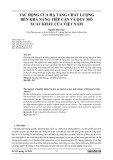
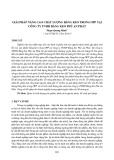
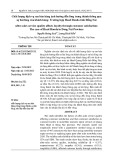
![Tài liệu học tập Quản trị chất lượng Phần 2: [Thêm mô tả cụ thể về nội dung phần 2]](https://cdn.tailieu.vn/images/document/thumbnail/2023/20231110/caongulam/135x160/1804834663.jpg)
![Tài liệu học tập Quản trị chất lượng Phần 1: [Mô tả chi tiết nội dung tài liệu]](https://cdn.tailieu.vn/images/document/thumbnail/2023/20231110/caongulam/135x160/1081892989.jpg)
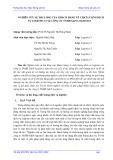
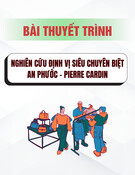
![Cẩm nang Bán hàng online từ A-Z hiệu quả cho người mới bắt đầu [Chuẩn Nhất]](https://cdn.tailieu.vn/images/document/thumbnail/2025/20251018/kimphuong1001/135x160/7751760756882.jpg)

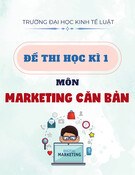
![Đề thi Quản trị marketing kết thúc học phần: Tổng hợp [năm]](https://cdn.tailieu.vn/images/document/thumbnail/2025/20251014/elysale/135x160/24261760434715.jpg)










